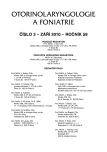Fundamentals of Radiofrequency Electrosurgery
Authors:
K. Matler 1; P. Klečka 1; I. Janík 2; Pavel Komínek 3
Authors‘ workplace:
ORL oddělení Nemocnice ve Frýdku-Místku, p. o, Frýdek Místek, primář MUDr. P. Klečka
1; Laserové léčebné centrum, Ostrava, primář MUDr. I. Janík, Ph. D.
2; Otorinolaryngologická klinika FN Ostrava, přednosta doc. MUDr. P. Komínek, Ph. D., MBA
3
Published in:
Otorinolaryngol Foniatr, 59, 2010, No. 3, pp. 156-163.
Category:
Comprehensive Reports
Overview
Electrosurgery was introduced in 1926 the H. Cushing, a neurosurgeon, and W. T. Bovie, a physicist. Since then, the application has been extended to become a commonly used method nowadays. Electrosurgical tools are also routinely used by otolaryngology specialists in many applications.
In spite of the routine use of electrosurgery, hardly any surgeon knows its basic principles. There are errors in the application and complete possibilities of electrosurgery are almost never exploited.
The contribution outlines the historical development. Basic principles of electrosurgery are described as well as physical properties of the histological effect and technological advancement. This knowledge is decisive for successful and safe application of electrosurgery in otolaryngology and other branches of medicine.
Key words:
electrosurgery, tissue effect, cut, coagulation, dessication, fulguration, coblation.
Sources
1. American National Standard for Electrosurgical Devices. HF18, 1994, American National Standards Institute.
2. Baggish, M.: Presence of human immunodeficency virus DNA in laser smoke. Lasers Surg. Med., 11,1991, s 197-203.
3. Bond, W. H.: Electrical hazards of disposable monitoring electrodes. Lancet, 1, 1975, s. 852-863.
4. Cushing, H.: Electrosurgery as an aid to the removal of intracranial tumors. Surg. Gynecol. Obstet, 47,1928, s. 751-784.
5. D’Arsonval, A.: Action physiologique des courants alternatifs. A grande frequence. Arch. Physiol. Norm. Pathol., 5, 1893, s. 401-408.
6. D’Arsonval, A.: Action physiologique des courants alternatifs. J. C. R. Soc. Biol. (Paris), 43, 1891, s. 283-286.
7. De Marco, M., Maggi, S.: Evaluation of stray radiofrequency radiation emitted by electrosurgical devices, Phys. Med. Biol., 51, 2006, s. 3347-3358.
8. Gatti, J. E., Byrnat C. J., Barrett, Noone, R., Murphy, J. B.: The mutagenicity of electrosurgical smoke. Plast. Reconst. Surg., 89, 1992, 5, s. 781-784.
9. Glover, J. L., Bendick, P. L., Link, W. J.: The use of the termal knifes in surgery: electrosurgery, lasers, plasmascalpel. Curr. Probl. Surg., 15, 1978, s. 1-78.
10. Greenwood, J. Jr.: Two point coagulation. A new principle and instrument for applying coagulation current in neurosurgery. Am. J. Surg., 50, 1940, s. 267-270.
11. Helfman, S. M., Berry, A. J.: Review of electrical safety and electrosurgery in the operating room. Am. J. Anesthesiol, 26, 1999, s. 313-320.
12. Hill, F. T.: Haris Peyton Mosher.Historical vignette. Arch. Otolaryngol, 47, 1966, s. 751-784.
13. Hoglan, M.: Potential hazards from electrocautery plume. Canadian Operating Room Nurs J., 13, 1995, 4, s. 10-16.
14. Hoglan, M.: Potential hazards from electrocautery plume. Canadian Operating Room Nurs J., 13, 1995, 4, s. 10-16.
15. Honig, N. M.: The mechanism of cutting in electrosurgery. IEEE Trans Biomed. Eng., 22, 1975, s. 58-62.
16. Hungerbuhler, R. F., Scope, J. F., Reves, J. G.: Ventricular fibrillation associated with use of electrocautery. A case report. JAMA, 230,1974, s. 432-435.
17. Krusen, F. H.: William Gilbert the father of electro-therapy. Arch. Phys. Ther X-ray Radium, 12, 1931, s. 737-743.
18. LaCourse, J. R., Miller, W. T., Vogt, M., Selikowitz, S. M.: Effect of high frquency current on nerve and muscle tissue. IEEE Trans. Biomed. Eng., 32, 985, 1, s. 82-86.
19. Litt, L., Ehrenwerth, J.: Electrical safety in the operating room: important old wine, disguised new bottles. Anesth. Analg., 78,1994, s. 417-419.
20. O’Connor, J. L., Bloom, D. A., William, T.: Bovie and electrosurgery. Surgery, 119, 1996, s. 390-396.
21. Pearce, J.: Current electrosurgical practice: hazards. J. Med. Eng. Technol., 9, 1985, s. 107-111.
22. Sagar, P. M., Meagher, A., Sobczak, S., Wolff, B. G.: Chemical composition and potential hazards of electrosurgery smoke. Br. J. Surg., 83, 1996, 12, s. 1792.
23. Sebben, J. E.: Electrosurgery and cardiac pacemakers. J. Am. Acad. Dermatol, 9, 1981, s. 457-463.
24. Smith, T. L., Smith, J. M.: Electrosurgery in otolaryngology-head and neck surgery: Principles, advances and complications. Laryngoscope, 111, 2001, 5, s. 769-780.
25. Sobben J. E.: Cutaneus electrosurgery. Chicago, Year Book Medical Publishers, 33, 1989, 43, s. 139-175.
26. Winstin, C.: The efect of smoke plume generated during laser and electrosurgical procedures. Minim Invasiv Surg. Nurs, 8, 1994, s. 99-102.
27. Wu, M. P., Ou, C. S., Chen, S. L, Yen, E. Y., Rowbotham, R.: Complications and recommendation practices for electrosurgery in laparoscopy. Am. J. Surg., 179, 2000, s. 67-73.
Labels
Audiology Paediatric ENT ENT (Otorhinolaryngology)Article was published in
Otorhinolaryngology and Phoniatrics

2010 Issue 3
Most read in this issue
- Harmless Decongescents and Provident Application of Decongescents
- Pepsin and Weakly Acidic Esophageal Reflux
- Vestibular Evoked Myogenic Potentials (VEMP) in Diagnostics of Vestibulopathies
- Czech Version of the Quality of Life Questionnaire for Patients with Chronic Rhinosinusitis SNOT-22 (Sino-nasal Outcome Test)
